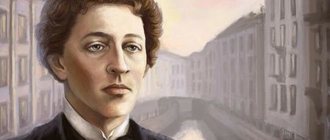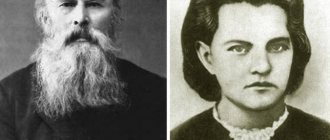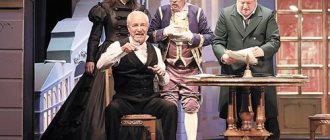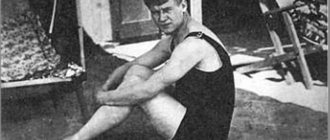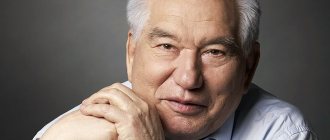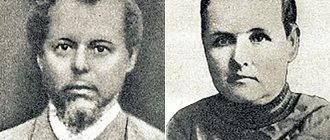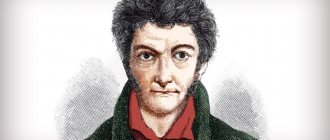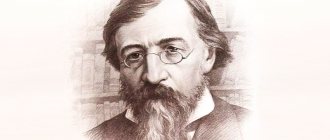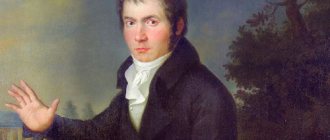Childhood and youth
Alexander Nikolaevich spends his childhood and early youth in Zamoskvorechye - an amazing corner of Moscow, where the peculiarities of merchant and bourgeois life are manifested.
When Ostrovsky was not yet 9 years old, his mother died (1831). In 1836, Alexander’s father married for the second time. His new wife was Baroness von Tessin. Emil Andreevna, the daughter of a Russified Swedish nobleman, raised her husband’s children as her own.
All this time, my father served in court. He rose to the rank of collegiate assessor, and in 1839 became a nobleman.
The family lived in prosperity, the parents paid a lot of attention to the education of their children. Home education was encouraged. Therefore, Alexander has had access to his father’s library since childhood. There he gets acquainted with Russian literature and its authors.
Civil service
In the early autumn of 1843, Alexander entered the office of the Moscow Conscientious Court as a first-class employee with an initial salary of 4 rubles. This court, organized under Catherine II, tried civil cases. Criminal cases that were subject to consideration in this court arose primarily from claims of parents against children. They affected crimes committed by deaf-mute people or minors. Cases caused by particularly unfavorable conditions were also subject to consideration. Alexander was forced to familiarize himself with numerous cases related to parental claims and lawsuits; disputes in trade and/or financial matters. It even happened to listen to repentance. In all cases, decisions had to be made fairly. So Ostrovsky, in a relatively short time, gained extensive knowledge about the family and social structure of the people and merchants, and discovered for himself the mystery of the life of the Old Russian family (in feudal Russia).
At the beginning of the winter of 1845, Ostrovsky took up the position of a clerical official at the desk “for cases of verbal violence” in the Moscow Commercial Court. Here his salary increased to 16 rubles. Alexander Nikolaevich had to work with cases of commercial insolvency, understand all sorts of sophisticated bankruptcy techniques, analyze to the subtleties the tricks of merchants trying to find a loophole in the laws, as well as tricks with creditors. Whomever did he meet when he sat at the table of a minor office official and carried out “verbal reprisals”. Among the traders there were city dwellers, peasants, merchants, and occasionally nobles. Thus, Ostrovsky listened to both sincere confessions and vague answers to questions, saw a wide variety of appearances, body movements, facial expressions, and heard non-standard turns of speech.
Subsequently, this provided the future playwright with a great service, providing him with an endless supply of information and types for literary creativity, which occupied a significant part of Alexander’s life, and also found its place in the creative biography of A. N. Ostrovsky.
The beginning of creative activity
Based on his observations from childhood and his service in the courts, Ostrovsky gravitated towards literature and creativity. By 1846, Alexander had already written many episodes from the life of a merchant. The playwright also came up with the idea for the comedy play “The Insolvent Debtor” (later “Our People – Let’s Be Numbered!”).
The strong influence of the natural school is noted in the playwright’s first experiments (essay “Notes of a Zamoskvoretsky Resident,” 1847). At the same time, the Moscow City Leaflet published his first drama, “The Picture of Family Happiness,” in one of its issues.
Real popularity came to the playwright only in 1850, after his comedy “Our People - Let’s Be Numbered!” was published in Moskvityanin. (formerly "Bankrupt"). She aroused great interest among the public. It received the approval of N.V. Gogol, I.A. Goncharov and others. However, it met with indignation among the merchant class, which is why its production in the theater was banned until 1861, and supervision was established over the author by order of Nicholas I.
At the same time, the future playwright was fired from service at the court (1851). Thus ended his legal career. From that moment on, Ostrovsky's biography made a sharp turn towards the literary field.
Brief biography of A.N. Ostrovsky: the life and work of the playwright | Litrecon
Ostrovsky's dramaturgy is found on theater posters and modern spectators, because his plays are eternal, and their content reflects the inescapable features of the Russian mentality. Therefore, the Many-Wise Litrecon pays special attention to the biography of the author so that the reader can better understand his work.
Birth and childhood
Playwright Alexander Nikolaevich Ostrovsky was born on March 31 (April 12), 1823 in Moscow. His father, Nikolai Fedorovich, worked in court for many years, and in 1839 he earned the title of nobleman. The boy was left without a mother early, but his stepmother also paid him enough attention. She realized the need for education, so she tried to give her children the best (Mikhail and Alexander).
Their house had a huge library: Alexander often spent a lot of time in it. From childhood he realized his passion for literature. In addition, the father's income allowed him to provide his sons with a quality education. Alexander was taught several languages at once. Ostrovsky knew not only German and French, but also Greek. Later he began to master other languages.
Youth and education
The father always wanted his son to choose a lawyer in the future. After graduating from high school, the young man entered Moscow University at the Faculty of Law (1840). However, Ostrovsky failed to complete it: after failing to pass the exam, he was expelled from the university (in 1843). The writer lost his passion for legal sciences.
Immediately after this, the father gets his son a job at the Moscow Conscientious Court, where Alexander served for seven years. The old man still did not lose hope of raising a successor and comrade-in-arms in his heir, but the young man was drawn to bohemia and creativity.
Creative path
Ostrovsky had a variety of nicknames: “Columbus of Zamoskvorechye”, “new dramatic luminary”. All of them are connected with the author’s creative path: it was he who showed the hidden areas of Moscow, merchant life, depicting the life of ordinary people.
The very first publication took place in 1847. Two works by the author were published: the play “Picture of Family Life” and the essay “Notes of a Zamoskvoretsky Resident”. However, the playwright experienced real success only after releasing the comedy work “Our People – Let’s Be Numbered!”
She brought him wide fame and recognition from authorities. But Ostrovsky’s plan could not be fully realized: the play was staged only once.
Due to a complaint from merchants, it was banned from the theater (the playwright received approval only in 1861), and the author himself lost his position in court.
Another creation of Alexander Ostrovsky, “Don’t Get in Your Own Sleigh” (1852), turned out to be more successful. From this year on, he regularly created dramatic works, which could often be seen in many major theaters. And since 1856, he was on the list of permanent employees of Sovremennik.
Many plays were written in this decade: “The Morning of a Young Man”, “An Unexpected Case”, “The Poor Bride” and others. Such works as “Don’t get into your own sleigh”, “Poverty is not a vice” do not expose the vices of the Russian person, but reflect the best traits of his character.
Chernyshevsky saw in this the artificiality of the writer’s position.
After a long expedition from the sources of the Volga to Nizhny Novgorod, the author again returns to his previous style of writing. He again denounces officials and shows the life of the poor population. The following plays were released: “A Profitable Place”, “The Pupil”, “The Thunderstorm”.
In the second half of the 1860s, discussions about the historical past of our country appeared on the pages of Ostrovsky’s works. He created plays touching on important events for Russia: “Kuzma Zakharyich Minin-Sukhoruk”, “Dmitry the Pretender and Vasily Shuisky”, “Vasilisa Melentyeva”.
Alexander Ostrovsky played an important role in the development of Russian theater. In 1866 he organized an Artistic Circle. Thanks to him, many Russian actors developed and improved their skills.
Interesting Facts
- Rimsky-Korsakov and P.I. Tchaikovsky wrote the opera “The Snow Maiden” based on Ostrovsky’s play.
- It was Ostrovsky who created the theater as we can see it now. The author carried out a reformation of the usual theatrical production and acting. His activities were subsequently continued by K.S. Stanislavsky, M.A. Bulgakov.
- In 1874, the playwright was one of the organizers of the Society of Russian Dramatic Writers and Opera Composers. He managed to improve the situation of the actors and make improvements to theatrical life.
- Since 1885, the author held a high position: he was the head of the theater school, and was also responsible for the repertoire of Moscow theaters.
- He knew the leading people of his era. He was often visited by such personalities as L.N. Tolstoy, I.A. Goncharov, F.M. Dostoevsky, M.N. Ermolova.
- While in a civil marriage with Agafya, Ostrovsky confessed his love to actress Lyubov Kositskaya. However, the girl never reciprocated the playwright’s feelings. In 1859, she was assigned the role of Katerina (“The Thunderstorm”).
- The playwright lived in debt all the time.
Despite the pension, which amounted to three thousand, the author’s high earnings were constantly short of money. Over time, exhausting work led to deterioration of health, and significant funds were required for treatment.
Ostrovsky and Russian Theater
Alexander Nikolaevich’s first play staged at the theater was “Don’t Get in Your Own Sleigh,” which the public saw in 1853. Further, for more than 30 years, his plays have been staged in the Moscow and St. Petersburg theaters.
Ostrovsky's plays laid the foundation for modern theater with their appearance. After all, he advocated realism on stage (without extreme situations), for the specificity of his characters’ phrases, revealing them to the maximum, and not relying on just one actor.
Because of his revolutionary vision of the theater, Ostrovsky had to found his own troupe, in which outstanding actors and supporters of the ideas of stage realism played. It is worth noting that the ideas of Alexander Nikolaevich’s theater were continued by Mikhail Afanasyevich Bulgakov and Konstantin Sergeevich Stanislavsky.
A. N. Ostrovsky: biography of the “Muscovite” and “pre-reform” periods
Ostrovsky's dramaturgy is gaining strength. During the period 1852-1860 the following events occur:
- Production of the play “Don’t Get in Your Own Sleigh.”
- Publication of the play “Poverty is not a vice.”
- Ostrovsky is a member of the young editorial board of the Moskvityanin magazine.
- Since 1856 - cooperation with the Sovremennik magazine. Acquaintance with L. N. Tolstoy and I. S. Turgenev.
- 1856 - participation in a literary and ethnographic expedition along the Volga. A wealth of material has been collected for future works.
Personal life of A. N. Ostrovsky
After his father received a noble title, Alexander Nikolaevich could not marry the commoner girl he loved. His chosen one was Agafya Ivanovna (surname unknown). He lived with her for 20 years in a civil marriage, without a wedding or legal marriage. They allegedly met in 1847. During their marriage, they had 4 children, 3 of whom died while their mother was still alive. Only the eldest son, Alexey Alexandrovich, survived his mother, but died at 27 years old. Ostrovsky did not leave his last name to him. The son was Alexandrov. Agafya Ivanovna died in March 1867.
In 1869, Alexander Nikolaevich married Maria Vasilievna Bakhmetyeva, a former actress. She gave birth to her husband 4 sons and 2 daughters. It was Maria Vasilievna who became the last wife of the playwright.
Personal life
Alexander’s personal life can hardly be called successful. He lived with a girl from an ordinary family, her name was Agafya. His chosen one had no education, but she was always the first to read Ostrovsky’s works. The girl always supported her lover. Unfortunately, their common children died in childhood. Alexander and Agafya lived together for almost twenty years.
In 1869, Ostrovsky married Maria Bakhmetyeva. The woman was an artist. There are six children left from their marriage.
